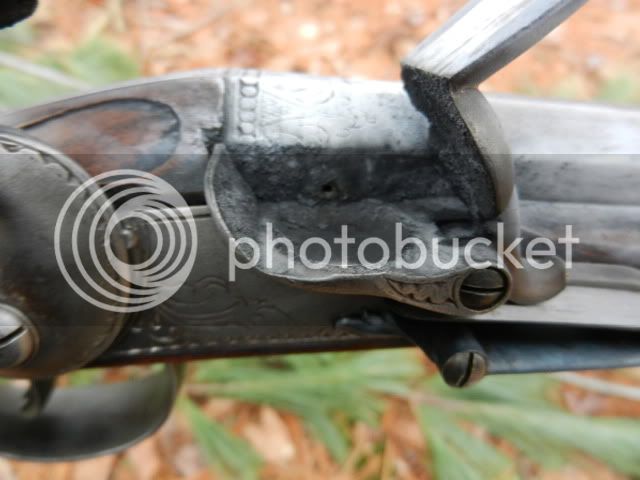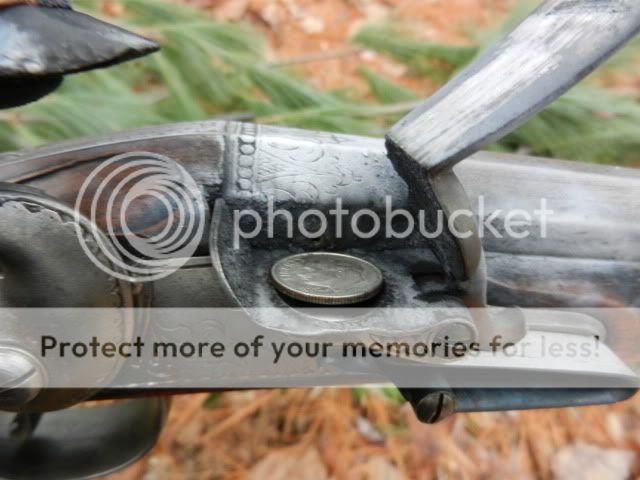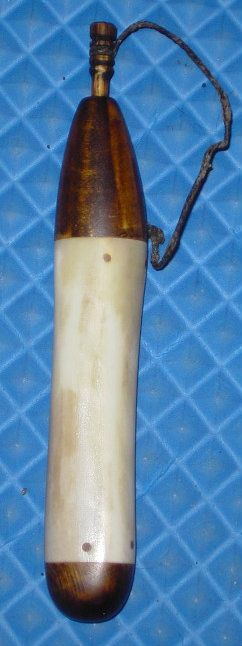-
Friends, our 2nd Amendment rights are always under attack and the NRA has been a constant for decades in helping fight that fight.
We have partnered with the NRA to offer you a discount on membership and Muzzleloading Forum gets a small percentage too of each membership, so you are supporting both the NRA and us.
Use this link to sign up please; https://membership.nra.org/recruiters/join/XR045103
You are using an out of date browser. It may not display this or other websites correctly.
You should upgrade or use an alternative browser.
You should upgrade or use an alternative browser.
pan powder amounts
- Thread starter oldnhbuck
- Start date

Help Support Muzzleloading Forum:
This site may earn a commission from merchant affiliate
links, including eBay, Amazon, and others.
I typically use 2-3 grains of 4Fg.
Snakebite
45 Cal.
I have a very small pocket powder flask and a small horn with a priming valve. The horn throws about two grains of 4F and I use it twice. I'm not sure how much the flask throws, but it amounts to a small line of powder in the pan, leass than 1/4" long. It looks about 4 grains. Both work well with very fast ignition.
oldnhbuck said:how much powder is normally put in pan?
2/3 full or more. Not so much as to be packed by the pan cover.
This will give the fastest most reliable ignition.
Dan
I'm with Dan.
Nice, big bed of powder to catch sparks but not so much it compresses under the heel of the frizzen.
Nice, big bed of powder to catch sparks but not so much it compresses under the heel of the frizzen.
Gee guy's, when I use that much pan powder I usually get "stung" by the falling embers against the back of my right trigger hand. In my experience, less is more. I have experimented at the shooting range seeing just how little 4F is needed to make the rifle shoot. With MY rifle, to get fast reliable ignition, it takes just a "spot" of prime powder. Dan and Chris are salesmen for the black powder company and they get paid commissions for selling more powder! :blah:
Captjoel said:Gee guy's, when I use that much pan powder I usually get "stung" by the falling embers against the back of my right trigger hand. In my experience, less is more. I have experimented at the shooting range seeing just how little 4F is needed to make the rifle shoot. With MY rifle, to get fast reliable ignition, it takes just a "spot" of prime powder. Dan and Chris are salesmen for the black powder company and they get paid commissions for selling more powder! :blah:
I started shooting FLs in my teens. I have seen people hog out vent on VERY nice rifle:

I used extensively with great success because the fool believed the BS that a little powder was better, faster than using a near pan full. THE RIFLE WOULD NOT GO OFF RELIABLY!! So rather than add 3 or 5 grains of prime he takes a awl or something to the vent liner.
In testing light charges are SLOWER than the heavier ones. Priming that COVERS the vent is faster than priming piled AWAY from the vent.
I can also attest that its MORE RELIABLE.
The firearm MUST fire when the trigger is pulled. In cold weather, in wind, in a clean dry pan when the powder shifts to cover only a small portion of the pan there is less area for sparks to land on so it SLOWS average ignition.
People who use coarse powder for prime may well have more chunks of powder flying around. Fine powder such as FFFF or Swiss Null B the granules are consumed before they can fly very far. Finer granules are also easier to ignite.
But people insist in living in la-la land where the testing that has been carefully done and the years of experience of HUNTERS mean nothing compared to something they likely read years ago and fell for. I read this "use a little prime its faster" bs YEARS AGO. I tried it. Found it WAS BS so I went back to using the lock as it was designed to be used.
One question, if you were hunting in "Occupied Grizzly Bear Habitat" as I often do how much prime would YOU use? Enough to barely cover the bottom of the pan or a pan full? Bearing in mind that actual testing shows the full pan is better?
Shooting is only a game. Hunting is dead serious regardless of the game. If the game is dangerous (we have 4 confirmed man killers in the mountains and plains of Montana, oops, 5 I forgot the Coyote) the firearm needs to work.
Dan
Many Klatch
69 Cal.
- Joined
- May 19, 2006
- Messages
- 3,498
- Reaction score
- 268
I don't use a priming horn, I prime with the same powder that is in the barrel 2f or 3f. I fill the pan, dump any extra powder if needed to level the pan and then close the frizzen. This has worked for me for a couple of decades. I have read all the tests with interest and then I keep on doing what I have always been doing.
Many Klatch
Many Klatch
Just gotta get one with the proper size and shape of pan. Note the 1/16" vent hole.


This was 30 shots without picking or wiping. No missfires.


This was 30 shots without picking or wiping. No missfires.
I do the same and it works well for me too, but there are those who will tell us we've been doing it wrong, even though it works well. :wink:Many Klatch said:I don't use a priming horn, I prime with the same powder that is in the barrel 2f or 3f. I fill the pan, dump any extra powder if needed to level the pan and then close the frizzen. This has worked for me for a couple of decades. I have read all the tests with interest and then I keep on doing what I have always been doing.
Black Hand
Cannon
- Joined
- Mar 17, 2005
- Messages
- 9,348
- Reaction score
- 896
I saw one guy prime years ago using the following:
He would lick his finger and wipe the pan. He added powder to the pan and immediately dumped it out. His prime was whatever stuck to the moistened pan. I don't remember how his ignition was.
Any which way, I prime with 3Fg and add enough to the pan to fill it better than 1/2 full. If I've done my job, the gun goes off. The only times the prime doesn't fire is when my flint is too dull to coax a spark from the frizzen, which has happened a half-dozen times in the last few years. Changing or knapping the flint solved the issue.
He would lick his finger and wipe the pan. He added powder to the pan and immediately dumped it out. His prime was whatever stuck to the moistened pan. I don't remember how his ignition was.
Any which way, I prime with 3Fg and add enough to the pan to fill it better than 1/2 full. If I've done my job, the gun goes off. The only times the prime doesn't fire is when my flint is too dull to coax a spark from the frizzen, which has happened a half-dozen times in the last few years. Changing or knapping the flint solved the issue.
Larry Pletcher
50 Cal.
- Joined
- Jul 27, 2006
- Messages
- 1,313
- Reaction score
- 67
In tests that I have done, I have not used the amount of priming powder as the variable. In each test I did, I used the same amount through out the test. Different tests sometimes used different amounts, but no intention was made to compare the ignition speeds with the amount of prime as the variable.
I did find that making sure priming powder is against the barrel is important. This is more important than the amount used IMHO. When I prime, I use the plunger type 2-3 times, tap the side of the gun to level the prime, and make sure the prime lies against the barrel. My barrel charge can be seen through the vent. I believe charges this close together ignite as one charge.
I want the pan totally covered. No spark should land in the pan and NOT hit powder. I think thats why Dan likes a large charge.
Regards,
Pletch
I did find that making sure priming powder is against the barrel is important. This is more important than the amount used IMHO. When I prime, I use the plunger type 2-3 times, tap the side of the gun to level the prime, and make sure the prime lies against the barrel. My barrel charge can be seen through the vent. I believe charges this close together ignite as one charge.
I want the pan totally covered. No spark should land in the pan and NOT hit powder. I think thats why Dan likes a large charge.
Regards,
Pletch
hanshi
Cannon
- Joined
- Dec 25, 2011
- Messages
- 9,335
- Reaction score
- 4,513
So would you say that if physically possible,for increased reliability, one should enlarge the pan as much as possible to create more surface area for sparks to hit as well as increase volume of powder to flash?
Are you interested in traditional locks or are you trying to redesign them?M.D. said:So would you say that if physically possible,for increased reliability, one should enlarge the pan as much as possible to create more surface area for sparks to hit as well as increase volume of powder to flash?
- Joined
- Dec 25, 2011
- Messages
- 9,335
- Reaction score
- 4,513
I'm trying to make existing locks within the parameters of their design, be as reliable as they can be made to be. Some apparently can be improved by tweeking a bit. MD
Similar threads
- Replies
- 33
- Views
- 2K





